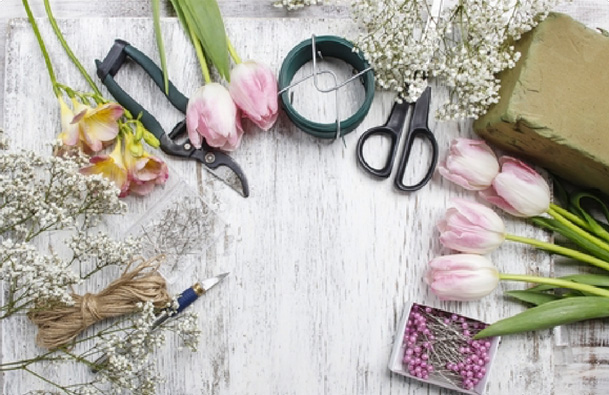
- Submerge the entire flower in water, this allows water to entire the flower through all its parts leaving it well hydrated. This works especially well for flowers like Hydrangeas that also drink or absorb water through their petals. This process of super rehydration will revive even wilting flowers if they are submerged for at least 20 minutes in either cool or cold water.
- Cut flower stems underwater to prevent bubbles from entering into the stem. It’s always a good policy to process flowers in a sink, bucket or under running water. This is especially true for flowers like roses that are considered ‘breathers’. This means that if cut in the open they take in air which creates a bubble in the stem, consequently inhibiting the flower’s ability to absorb water. If you suspect that your flowers are struggling to get adequate water, recut the stem underwater.
- Remove lily stamens gently making sure the stamens don’t touch the lily in the process. This is because if lily pollen comes in contact with the petals it eats away at the delicate blooms, drastically shortening their life span. For lily with protruding stamens like the Stargazer variety, it is easy and advisable to remove the stamens. For varieties like Calla lilies were the stamens are not easily accessible it best to leave the stamens intact.
- Top up your water a little bit daily and change it completely every few days. Once cut flowers are technically dying slowly, but there are ways to slow down or suspend the process. One of the ways is by ensuring that the flower gets as much water as possible so that it can thrive. This means that for flowers in form arrangements the foam will eventually dry out and must be regularly topped up with water in order to remain moist. Similarly, for flowers in a vase, the water level will go down due to evaporation and the flower itself drinking up the water, therefore the water must be topped up daily and changed out every other day.
- Cut a few inches off the stem every few days. It’s important to remember that your cut flower isn’t technically alive anymore and sure the end of the stem where it was cut will become covered in slime limiting the flower’s ability to absorb enough water. Cutting off about an inch from the end of the stem every few days will help prolong flower vase life.
- Remove all foliage below the water line to prevent water from getting swampy. It’s important to try and keep the water bacteria-free as much as possible for as long as possible. Leaves tend to rot and carry bacteria and microorganisms that quickly contaminate the water. Adding a little bleach to the water also helps.
-
When preparing roses don’t strip off the entire throne from rose stems as this lets air into the stem inhibiting the rose’s ability to absorb water. Just cut off the sharp end. As mentioned before, roses are ‘breathers’ that absorb oxygen preventing effective water absorption.

- High-quality water for flowers should be slightly acidic with a pH of 3 to 4.5. Most tap water is neutral and acidity can be obtained by using a commercial floral preservative. Flower stems take up acidic water more readily than neutral or alkaline water.
- Cut flowers are not the only ones that need special care and attention. Some live flowers like orchid are especially sensitive and require skilled care. The biggest killer of potted plants is overwatering. Overwatering drowns the roots of a flower preventing it from absorbing the oxygen it needs to survive. To prevent over watering you can use the ice cube method being careful to avoid placing the ice cubes directly on the plant (roots, crown, leaves). This is especially important for orchid as they are tropical flowers that don’t enjoy the cold.
- How to know if your orchid is receiving the optimal amount of water? Watch out for the telltale signs from the roots:
- Healthy green roots indicate that your orchid is sufficiently watered.
- Greyish- white root color indicates insufficient water supply.
- Brown and mushy roots show that your orchid is in danger of root rot and you need to take mitigating measures immediately.




